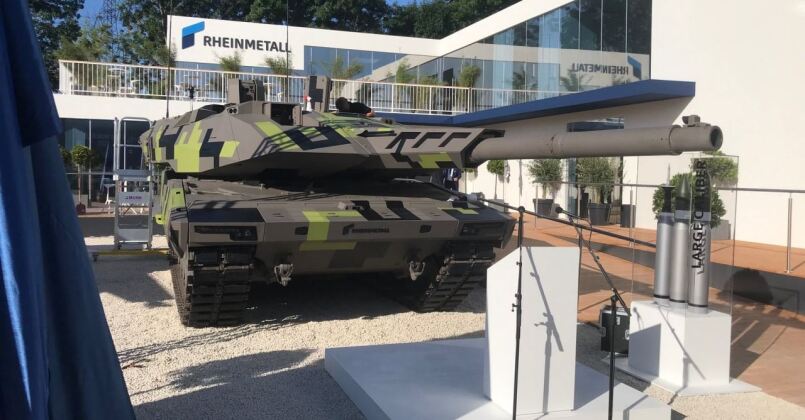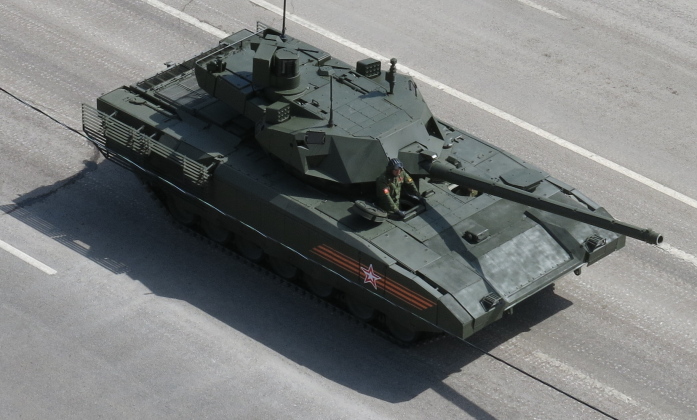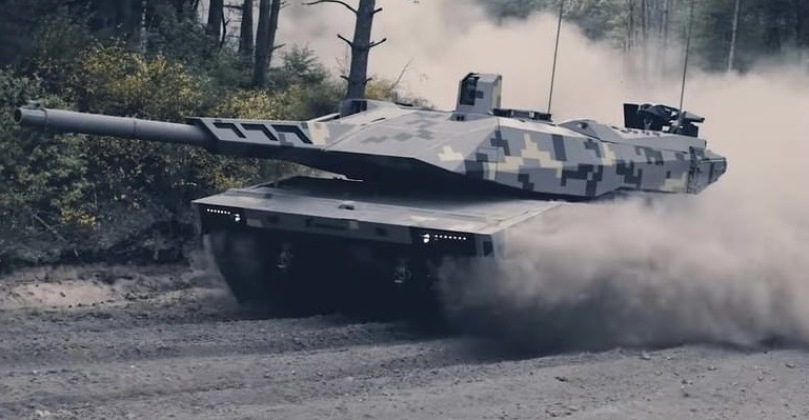Germany’s Rheinmetall has presented its first new battle tank since the 1970s the KF51 Panther – a successor to the Leopard and Leopard II of the Cold War era with a name recalling the Nazi era Panzerkampfwagen V Panther that served from 1943. The vehicle’s appearance has been widely speculated to be timed to follow the outbreak of war in Ukraine earlier in the year which led to newfound importance being attributed to armoured warfare in Europe. Rheinmetall has been speculated to be working on a new tank since at least 2014-15, when a rise in hostilities with Russia followed by an unveiling of the Russian T-14 Armata next generation tank was seen to have added urgency to such a program. Unveiled at the Eurosatory land defence exhibition in Paris, the vehicle follows the trend set for next generation vehicles by the T-14 of having an unmanned turret to facilitate a reduced weight and accommodate a larger main gun. Also like the T-14, this technology has been touted as a path to potentially developing the Panther into a fully unmanned tank in future. While Soviet tanks have adopted autoloaders since the 1960s, which are today common to all non-Western tank designs, the Panther is the second Western tank after the French Leclerc to use such a system which will facilitate a faster rate of fire and a crew reduction from three to four. Although largely new, the tank is not an entirely clean sheet design with its hull being based on the Leopard 2 from the 1970s.

Where 125mm guns arm most modern Russian, Chinese and North Korean tanks, with the T-14 expected to integrate a 152mm gun in future, the Panther has been more modestly up gunned from the NATO standard 120mm to a 130mm gun – the Rheinmetall Future Gun System. This follows plans in the 1980s for the U.S. Army to integrate its M1 Abrams tank with a 140mm gun which never materialised, but may accelerate efforts in Russia to integrate a 152mm gun onto the T-14. The Panther benefits from greater protection than the latest Leopard II variants without compromising its weight, and integrates a Top Attack Protection System (TAPS), the ROSY smoke/obscurant system, and digital NGVA architecture facilitating employment of sensors to detect launch signatures and thus better respond to threats. It further integrates the Rheinmetall StrikeShield active protection system. The tank has greater mobility than existing Western designs, and will benefit from use of the HERO 120 loitering munition allowing it to fire on targets beyond its line of sight.

The Panther’s gun has been marketed as being “more than 50 percent more effective” than the Leopard 2’s and offering “much longer range,” while being able to fire both kinetic energy saboted projectiles and a range of programmable explosive ammunition types. This again mirrors the T-14, which even with its 125mm gun boasted a 2000m engagement range triple that of any Western tank. Alongside a 12.7mm coaxial machine gun, an optional remote controlled weapons station will allow it to deploy littering ammunition, drones, missiles and possibly even defensive anti aircraft weapons depending on how the tank is configured. It remains uncertain how the Panther’s unveiling could affect work on the joint Main Ground Combat System program being pursued jointly by France and Germany, but this will likely depend on whether and in what numbers the Germany Army intends to integrate the Panther and how soon it is ready for service. The tank may well be considered a stopgap until the newer design is ready for service, which may take until the 2040s.

The Panther is the first new Western tank to be developed since the Cold War, other than the British Challenger 2 which entered service in 1993 over 30 years before the new German design will be combat ready. With both Russia and Western powers having invested relatively little in clean sheet tank designs after the Cold War, with the T-14 being the notable exception albeit one which has yet to be fielded in significant numbers. There is a high possibly that the Panther’s unveiling could fuel accelerated development of new tanks in the United States, Russia, and possibly in East Asia and in European countries such as Britain and France which have not produced tanks for some years. Indeed, with the Leopard 2 and American M1 Abrams having initially been pursued as part of a joint program and sharing many design aspects, the possibility that the hull of the Abrams could see a similar modification in the near future in coordination with the German program and to ensure compatible ammunition, remains significant. Like the T-14, the Panther threatens to disrupt the status quo in the West and Russia where conservative investments on both sides have meant no party is willing to invest heavily in a new 21st century design in order to reduce expenditures. The extent to which the Panther may fuel a new tank arms race remains to be seen.
